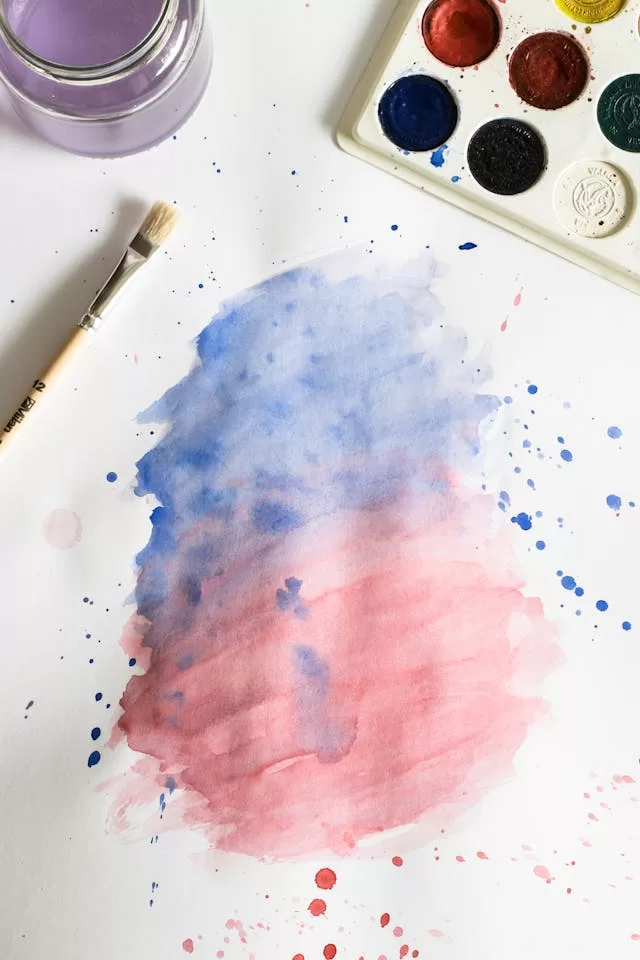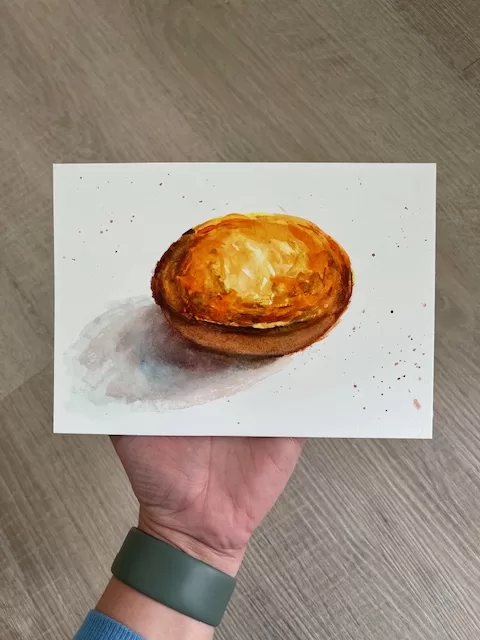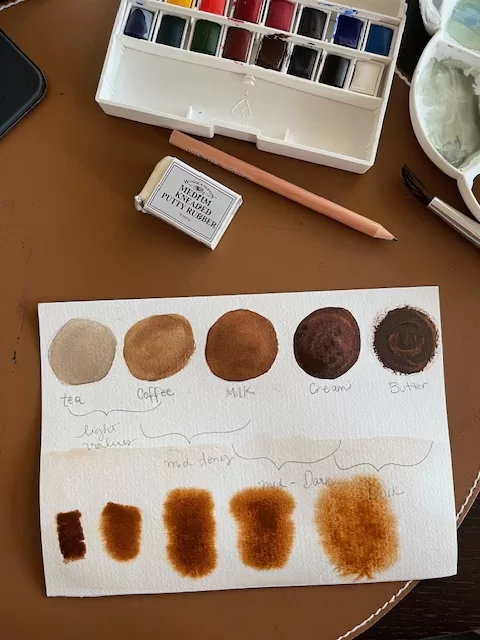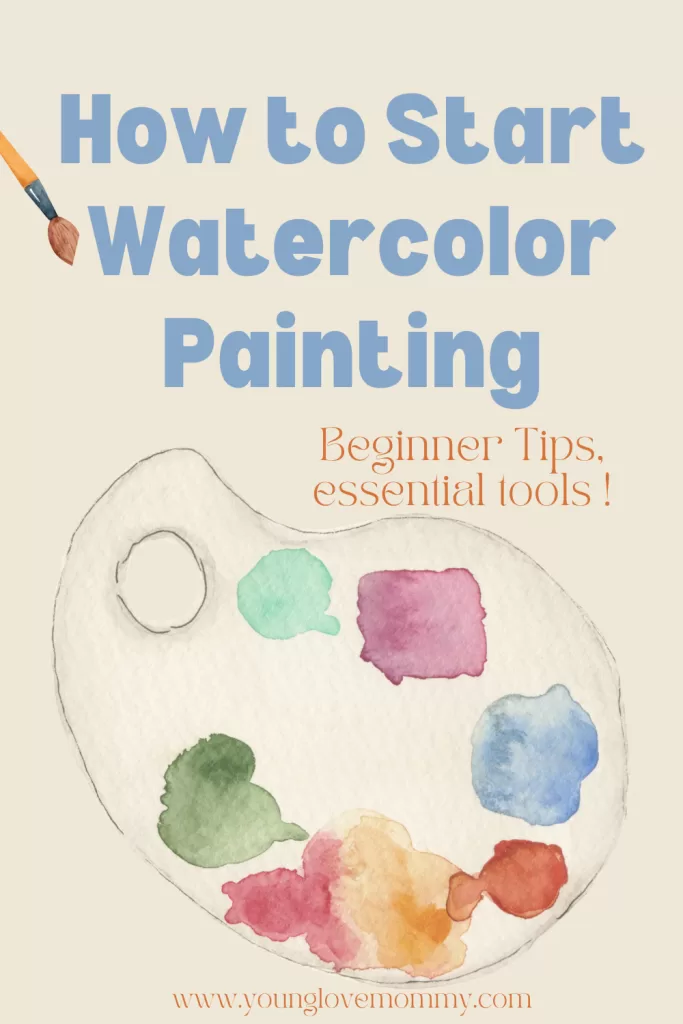Have you ever dreamed of learning watercolor painting but didn’t know where to start? I was in the exact same place not long ago. Now, this peaceful hobby has become one of my favorite parts of the week—and today I’m sharing how you can get started too.
“This post contains affiliate links, which means I may earn a small commission at no extra cost to you.”

🧡 Why I Started Watercolor Painting
In March 2024, something in me craved quiet creativity. As a mom of two (now with a third on the way! Surprise!), my days were full of noise, schedules, and to-do lists. I missed that feeling of doing something just for me. That’s when watercolor found me.
I’d always admired watercolor art—the softness, the transparency, the unexpected ways the paint moves across paper. But I thought it would be too hard, too messy, or require too much of my time.
Turns out? It can take as much or as little time or mess I want.
Watercolor became more than a hobby—it became therapy. A moment of peace. A space where I could breathe, play, and express myself, even if just for 20 minutes during nap time or before the house wakes up.
If you’re longing for something gentle, calming, and creative… watercolor might be exactly what your soul needs too.
🎨 What Makes Watercolor So Special?
Watercolor is one of the most forgiving mediums for beginners. You don’t need expensive tools, a big studio, or formal training to begin. All you need is a small space, a little water, and an open mind.
Here’s why I think watercolor is the perfect hobby—especially for busy moms or anyone craving a peaceful creative outlet:
- ✨ It’s low-pressure: Mistakes often turn into beauty.
- ✨ It’s affordable: A small starter kit is all you need.
- ✨ It’s portable: Paint anywhere—from your kitchen table to the park.
- ✨ It’s soothing: The soft flow of paint and water is genuinely relaxing.
🧰 Basic Watercolor Supplies for Beginners

Everything you need to get started—without wasting money on the wrong stuff!
When I started, I researched way too much and got overwhelmed with choices. You really don’t need a big haul. I went a bit overboard with my supplies, but you can learn from my mistakes and only buy what’s really needed when starting out with watercolor.
Below is a curated list of my favorite beginner tools—with Amazon affiliate links so you can shop easily and support the blog (thank you 💛).
1. Watercolor Paints
💡 Start small—just a few good colors will take you far.
- 🎨 Winsor & Newton Cotman Watercolor Set (16 half pans)
Affordable, great quality, and lasts forever. - 🎨 Paul Rubens Student Watercolors (24 colors)
Highly pigmented, dreamy colors, and a beautiful pink tin.
Pro tip: Pan sets are easier to control for beginners. Tubes are better when you start mixing your own shades.
2. Watercolor Paper
💡 Don’t skip this! If you really want to watercolor -you’ll need watercolor paper. Regular paper will wrinkle and bleed. I have several brands I use, but here are two options to look into.
- 📄 Canson XL Watercolor Pad (140 lb)
Great quality for the price. Cold press texture is perfect for beginners. There are also lots of sizes to choose from. - 📄 Arches Cold Press Watercolor Paper – 100% Cotton
A splurge, but a total game-changer once you’re ready.
Look for 140 lb or higher weight and “cold press” (it has a nice texture).
3. Brushes
💡 You don’t need a big set. 2-3 is plenty! I’ve acquired more than 20 brushes so far – but I have my favorites and some that just sit there. Once you get farther along in your watercolor journey, you can look into delving into the world of brushes – there are so many options.
- 🖌️ Princeton Velvetouch Round Brush – Size 6 or 8
- 🖌️ Da Vinci Cosmotop Spin – Detail Brush, Size 2 or 4
These brushes hold water beautifully and are super durable. A round brush is your go-to for petals, leaves, washes, and details.
4. Mixing Palette, Jar, Towel
I did not heed this advice, I do have several watercolor palettes and ceramic watercolor palettes but there’s no need to buy fancy extras—here’s what I recommend you use to start:
- A white ceramic plate (for mixing)
- A glass jar or mug (for water) – for on the go painting – use this.
- A clean dish towel or paper towels (for blotting)
Want to upgrade? Try this Airtight Folding Watercolor Palette that fits in a tote bag!
🌿 Beginner Tips to Help You Fall in Love with Watercolor
Starting something new can feel intimidating—but watercolor is all about letting go. These are the tips I wish someone told me early on:

1. Start with Simple Shapes
Begin by painting circles, leaves, or abstract blobs. Don’t aim for perfection—focus on how the paint flows.
2. Swatch Your Colors
Before diving into a painting, try a color chart. It helps you get to know your paints and how they behave when wet vs. dry.
3. Embrace the Water
Water is your most important “color.” Play with how much water you use—it completely changes the results.
4. Use Light Layers
Watercolor is transparent. Instead of painting all at once, build layers slowly. Let each dry before adding more.
5. Watch Free Tutorials
There are amazing beginner and intermediate friendly tutorials on YouTube. A few of my favorite channels are:
- Chris Petri – this was the first channel I began following watercolor tutorials from – he has extreme beginner videos which are quite helpful.
- De Winton Paper Co. – I love her tutorials – they are easy to follow and beautiful.
- Yong Chan – His tutorials are so different, he’s so talented and halfway through his tutorials I wonder what I’m doing and if anything is gonna come out of it – I’m pleasantly surprised in the end.
📦 My Beginner Watercolor Kit (Shopping Links)
To make it easy, here’s a complete list of tools I use and love:
- ✅ Winsor & Newton Cotman Paint Set
- ✅ Canson XL Watercolor Paper Pad
- ✅ Princeton Round Brush, Size 6
- ✅ Mixing Palette or Ceramic Plate
- ✅ [Water Jar, Paper Towels, Patience 😉]
You can start with all of these for under $60—and they’ll last you a long time.
💬 Final Thoughts on how to start watercolor painting
Watercolor painting has brought so much joy, peace, and creative expression into my life. If you’ve been looking for a hobby that soothes your soul, I truly encourage you to give it a try.
You don’t have to be “artistic.” You just need curiosity, a brush, and a little time to yourself.
✨ If you try watercolor after reading this, please let me know in the comments or tag me on Instagram—I’d love to cheer you on!
👉 Stay tuned: In my next post, I’ll be sharing unique gift ideas for watercolor lovers—perfect for birthdays, holidays, or even a “treat yourself” moment.
📌 Save this post for later:
How to Start Watercolor Painting – Beginner Tools, Tips & My Story

READ NEXT:
For a fun project, try creating your own coasters with this DIY Watercolor Coasters Tutorial

Leave a Reply